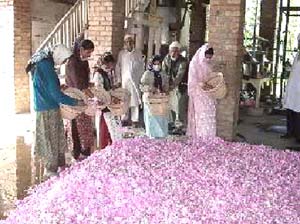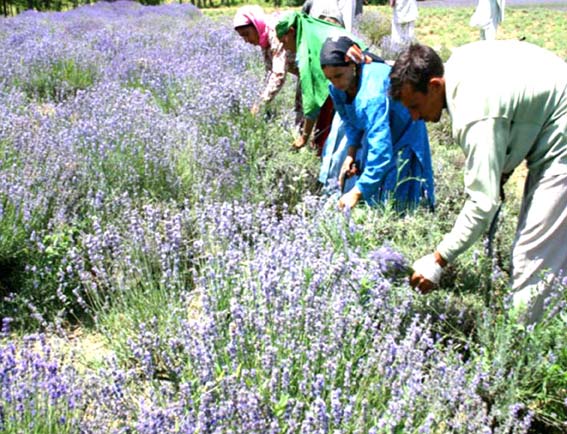Three men saved Kashmir’s lone drugs research laboratory from becoming history. Recently vacated by CRPF after 25 years the centre is set to revolutionize drug research in Kashmir. Saima Bhat reports the change that will benefit the farmers across Kashmir.
In 1989, when militancy broke out in Kashmir, employees from outside the valley fled in droves. With nobody to take care of these government offices and buildings, most of them were turned into garrisons for forces. Regional Research Laboratory, which once buzzed with activity, was under CRPF occupation for last 25 years. Majority of its staff has migrated to either Jammu or other Indian states.
For last two and half decades, the place was manned by just one scientist, Dr AS Shawl and two technicians – Nasir Ali and Abdul Majid Chesti.
“It was because of them that this institute was running till 2005,” says Dr Qazi Parvaiz Hassan, who is a senior scientist in life sciences division in CSR-IIIM since 2007.
The lab recently came into focus when the Director General of Council of Scientific & Industrial Research (CSIR) announced for the up gradation of its Srinagar branch as a full- fledged centre, CSIR-IIIM Centre Srinagar at Sanat Nagar.
The lab was started in 1941 as Drug Research Laboratory but soon it was taken over by the CSR in 1957 and its name was changed to Regional Research Laboratory, with its main office in Jammu and a branch office in Srinagar.
In 2005 its name was again changed to Indian Institute of Integrative Medicine (IIIM) as the laboratory was mainly dealing with drug discovery from natural resources and microbial species. But with time the laboratory has become a multi disciplinary institute having many offshoots like biotechnology, pharmacology, plant bio diversity, quality control labs for quality check up of products, microbial biotechnology divisions and many more.
“We have a gene bank of aromatic medical plants and it is the best one in India as we have 100 to 150 high altitude medicinal aromatic plants. Such a variety is not available in any field station in India. This gene bank is there since the start of this laboratory,” says Dr Qazi.
Moreover six to seven species of mint were produced in this lab during the period of turmoil. Dr Qazi says that these species of mint were transferred to South India like Kerala. Presently Kerala is the largest producer of mint.
With a team of 10 young scientists and 20 PhD students, the institute was given a facelift by the new Director CSIR-IIIM, Dr Ram Vishwakarma, where scientific activities came to an end in 1989 following the kidnapping of its then in-charge, A K Dhar, who spent almost two months in captivity at the peak of militancy.
In the first phase of its revival, around Rs 3.5 crores were spent, in the second phase Rs 2.5 crores were spent. Besides the field stations were fenced – in form of chain link at the cost of Rs 8-10 crores and many more projects are in the pipeline.
 Now, the institute has been entrusted with the task of creating an aroma industry in the state. Dr Qazi says, “We are focusing on the exploration of high altitude medicinal aromatic plants of this region. As we have lot of biodiversity, our mandate is to explore these bio resources. We take them to our lab where we check their DNA, secondary metabolites, and then these metabolites are converted into drugs.”
Now, the institute has been entrusted with the task of creating an aroma industry in the state. Dr Qazi says, “We are focusing on the exploration of high altitude medicinal aromatic plants of this region. As we have lot of biodiversity, our mandate is to explore these bio resources. We take them to our lab where we check their DNA, secondary metabolites, and then these metabolites are converted into drugs.”
So far the laboratory has been working on the drugs like Neuro regenerative medicines, Anti Tuberculosis Drugs- Resorine. Dr Qazi says that this lab is actively working on pure isolates of bioactive molecules, pure molecules of bioactive molecules, explore bacterial flora, high altitude medical aromatic plants. “We first check it and then use them as anti cancer, anti microbial, anti rabies, amino modulatory activities – where molecules are used for suppressing or boosting the immune system. Besides that we are working on both in-vitro and in-vivo cytotoxic activities against different cancer cell lines, Neurocyto toxic activities,” says Dr Qazi.
Dr Qazi remembers last time the IIIM Srinagar gave a consignment of 25 quintals of anti-malaria drug Artemisia-annua to a pharma company. He adds that many more companies approach them for pure basic materials.
All the work of CSR-IIIM is being done at its three field stations located at Bonira Pulwama which is spread over 160 hectares of land, Yarikha Tangmarg-spread over 10 hectares of land and another station at Verinag Islamabad. All the three stations are used for the cultivation and practices of high altitude medicinal plants as well as aromatic plants.
The lab develops end to end technologies, right from the nursery till the production and harvesting of these plants. Besides that the lab raises elite varieties of these plants. “Till date this institute has developed end to end technologies for at least 10-15 front line aromatic medicinal plants like lavender, rose, rose damascene, rosemary and many more products,” says Dr Qazi.
These end to end technologies have been passed on to two local farmers and two entrepreneurs. Moreover there are 10-15 entrepreneurs who are growing these aromatic plants on large scale including Khyber Bio-culture (rose and lavender), Fasiam Agro Farms, Fashion Agro Biotech, Mehak Herbals and many more.
Recently Kashmir was declared as the ‘herbal state’ and even the chief minister of the state has accepted that Kashmir has a lot of potential to produce aroma plants. The scientists at the Srinagar Lab say that he is very cooperative.
Dr Qazi feels there are still many more aromatic plants which have not been explored till date. The CSR-IIIM in collaboration with tourism department is going to use the barren land under tourism department for the cultivation of various products including lavender.
For this, the soil in Gulmarg, Dodpathri, Pahalgam, Bangus has been already sent for testing. “We have indentified land at these places where aromatic plants will be grown and this will serve three purposes- one it will make these places more pleasant, and 2nd is we will be getting products and third it will help in beautification of these places,” says Dr Qazi. He adds the barren sloppy land will look more beautiful and besides that it will generate economy to state.
As per the Indian market value one kilo gram of lavender costs Rs 7000 to Rs 8000 and one kilo grams of rose oil costs between Rs 7 to Rs 8 Lakhs.
Farmers with vast tracts of sloppy land are given end to end technologies. “Our effort at the time is to extent the production of these medicinal aromatic plants to the local farmers, particularly those who otherwise get lesser returns from their fields,” says Qazi.
Presently these products have been extended to places likes Drass, Gurez, Kargil where active season for farmers is very less. Varieties like Mentha, lavender, rosemary have been cultivated and are under trail since last two years.
For the further development of this institute and help more rural people, the lab has established its own extraction units. And in its recent innovative move, the director of the Lab is going to start an Innovative Center, the idea has been already approved by the center, where the end products from the farmers will be sold at market value, CSR will be converting that oil into products in form of value edition, after which it will be sent to the local market and in the Indian markets.
“It will be like an oil bank and it will be a buy back system,” says Dr Qazi and adds, “After selling it in market if we get good profit then some share from that will be given to the farmer back as our aim is rural prosperity. This lab is a non- profit organization, we don’t need money, we just want to boost the economy of farmers.”
A lavender spray costs Rs 200 to Rs 300 but if it gets processed in Kashmir the lavender spray will be pure organic and with its industry it will generate employment.
To reach out to more people the CSR IIIM Srinagar has hired an NGO- NWF- for its extension in localities where a local will come to this NGO and he/she will be given all information about the plants and then the soil from his land will be sent for checking. All these processes will be free of cost and the plants will be provided at very nominal rates.
Recently a Nuclear Magnetic Resonance (NMR) machine was established in the CSR IIIM Srinagar. It was the first such machine to be installed in Kashmir. The machine is used by chemists for characterization of secondary metabolites. These molecules then get converted into drugs but before that their characterization has to be done through different stages and their NMR will be done here.
For NMR, the CSR has signed an MoU with the Kashmir University, SKUAST and SKIMS so that their students can also use this only machine in the state.
Since 2005, IIIM started running training Center for skill development in the production of leather goods. This unit imparts training in leather goods and garment making to unemployed women and youth of Kashmir valley through skill development program.
This is a scheme where students are taught how to process the raw hides so that they can process them here in Kashmir and then can sell them off. Otherwise the raw hides are exported to other states of India at very nominal charges but when final products are brought here, they are sold out at 10 times higher prices, says Dr Qazi who is heading this programme.
Recently when Union Minister for Science and Technology and Earth Sciences, Jaipal Reddy was in Kashmir ,he made five announcements to upgrade and strengthen the CSIR-IIIM in the State. He announced Central support for two Bio-Technological Parks, World Class Value Addition Centre for Aroma, State-of-the-art Leather Centre, Science Museum and Academy of Scientific Research.
And on the same occasion the Director Dr Ram Vishwakarma said that CSIR is conducting research at its seven centers to utilize bio-mass of Dal Lake for producing diesel, energy and fertilizers.

















This is what I have understood from this article.
Drugs research lab has been saved, new research work had been and is being done, new equipment brought, support from the government, etc. Rest of it was a little too technical for me.
But hey, it is all good news.
Your articles are always informative.